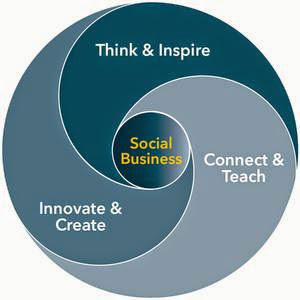However, in a time when traditional sources of revenue for universities are shrinking and expenses are rising, it can be a struggle for universities to excel even at their core activities of research and teaching, let alone spur growth and innovation. Though it may seem antithetical to faculties who are struggling to make ends meet to cover the teaching needs required of them, I would argue that the way to overcome this challenge is through investing resources in developing deep partnerships with industry.
Yes, it's true that industry-academic partnerships are flourishing these days within fewer universities, as
companies become very strategic and work with only those institutions that
align with their specific needs.
Corporations are investing (both philanthropic and research dollars)
less frequently and in smaller amounts due to a dramatically changing
corporate landscape of mergers, consolidations, and unpredictable markets. But these conditions can be overcome if corporate relations and advancement offices at institutions of higher education rethink their opportunities for deepening their relationships with
partners. It is not sufficient any longer for development staff to work solely
with companies on gifts, nor for research staff or faculty members themselves to work solely on sponsored research agreements. According to a 2011 white paper published by the Network of Academic Corporate Relations
Officers "corporations no longer consider themselves 'donors' to
academia; they consider themselves 'investors’, and as corporations approach
colleges and universities on an enterprise level rather than a philanthropic
level, they are looking to institutions as partners in solving the needs of
their organization.”
These
needs include dealing with decreasing in-house R&D for broad future-looking
research, and the retirement of baby boomer employees leaving a huge gap in
human capital. Universities can help companies
overcome these problems by offering faculty and student research partnerships
and working side by side in research labs, by building an early and customized talent
pipeline, and by offering customized and ongoing professional development,
executive education and skills upgrading.
The size of investment
a university receives from a company will depend in part on the number and
quality of these engagements. When universities engage companies on an
enterprise level and help them fill their needs, the investment that flows in
return, including philanthropic investment, will greatly increase.
What that means to universities is better classrooms, labs and equipment. It means more research funding and unique projects to collaborate on. It means more jobs and experiential learning opportunities for students which then allows for greater recruitment success and repuational growth. Which in turn leads to more revenue and more investment in faculty recruitment and retention.
What that means to universities is better classrooms, labs and equipment. It means more research funding and unique projects to collaborate on. It means more jobs and experiential learning opportunities for students which then allows for greater recruitment success and repuational growth. Which in turn leads to more revenue and more investment in faculty recruitment and retention.
Deep partnerships build the human capital needed to drive innovation and growth. Over time, a well-managed alliance produces a growing number of students, graduates, researchers, corporate employees and leaders who connect in key areas of interest and work harmoniously to define big and common strategic goals.
Deep partnerships require deep knowledge and understanding of the parties involved, including their mission, values, goals, needs, processes, people and resources. They are about developing a mutual respect and desire for mutual success. They are about long-term vision and innovative thinking. And so they need to be invested in as a priority of the universitiy, and resourced properly. Different universities may have different solutions for resourcing this work, but certainly they need to collaborate across campus to work with corporations in a unified way.
The academic world may sometimes still be leery of corporate partnerships and the university resourcing directed to attracting and retaining them. However, deep partnerships will benefit every part of the university and deliver value to all of it's stakeholders (including communities and economic regions) in the long term. For universities who wish to continue to birth new innovation and cultivate new generations of thinkers, builders and leaders, deep partnerships must be part of their vision and supported at every level.
Deep partnerships require deep knowledge and understanding of the parties involved, including their mission, values, goals, needs, processes, people and resources. They are about developing a mutual respect and desire for mutual success. They are about long-term vision and innovative thinking. And so they need to be invested in as a priority of the universitiy, and resourced properly. Different universities may have different solutions for resourcing this work, but certainly they need to collaborate across campus to work with corporations in a unified way.
The academic world may sometimes still be leery of corporate partnerships and the university resourcing directed to attracting and retaining them. However, deep partnerships will benefit every part of the university and deliver value to all of it's stakeholders (including communities and economic regions) in the long term. For universities who wish to continue to birth new innovation and cultivate new generations of thinkers, builders and leaders, deep partnerships must be part of their vision and supported at every level.


